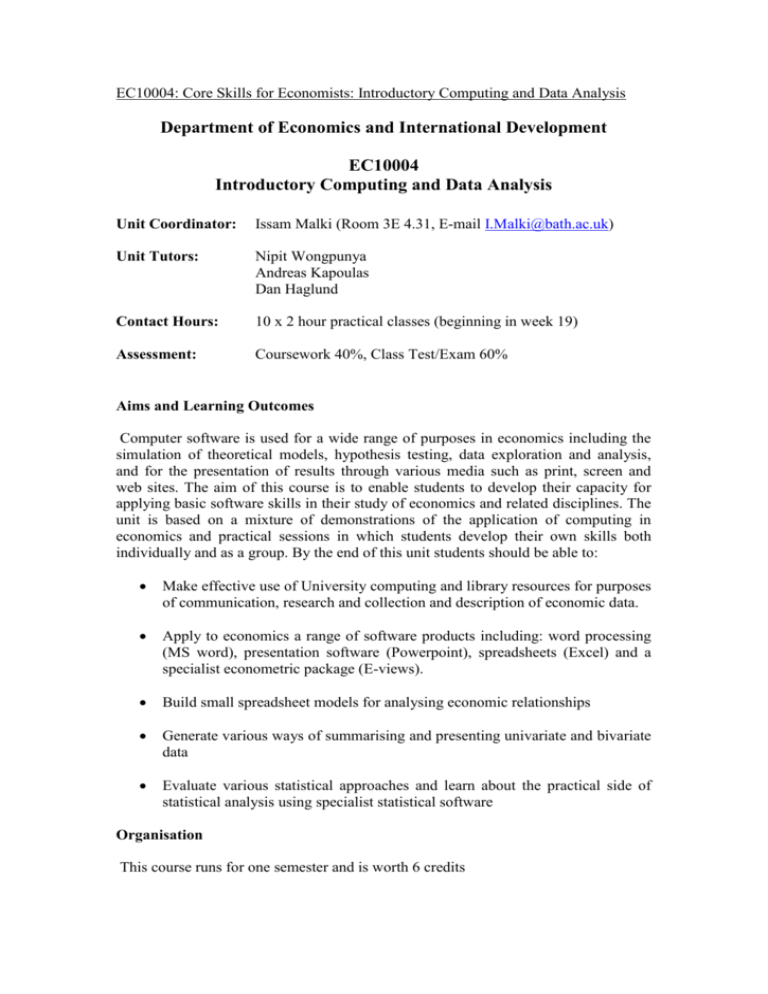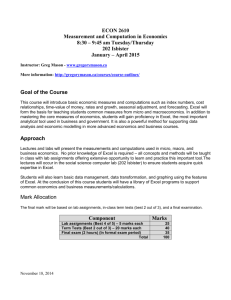EC10004: Core Skills for Economists: Introductory Computing and
advertisement

EC10004: Core Skills for Economists: Introductory Computing and Data Analysis Department of Economics and International Development EC10004 Introductory Computing and Data Analysis Unit Coordinator: Issam Malki (Room 3E 4.31, E-mail I.Malki@bath.ac.uk) Unit Tutors: Nipit Wongpunya Andreas Kapoulas Dan Haglund Contact Hours: 10 x 2 hour practical classes (beginning in week 19) Assessment: Coursework 40%, Class Test/Exam 60% Aims and Learning Outcomes Computer software is used for a wide range of purposes in economics including the simulation of theoretical models, hypothesis testing, data exploration and analysis, and for the presentation of results through various media such as print, screen and web sites. The aim of this course is to enable students to develop their capacity for applying basic software skills in their study of economics and related disciplines. The unit is based on a mixture of demonstrations of the application of computing in economics and practical sessions in which students develop their own skills both individually and as a group. By the end of this unit students should be able to: Make effective use of University computing and library resources for purposes of communication, research and collection and description of economic data. Apply to economics a range of software products including: word processing (MS word), presentation software (Powerpoint), spreadsheets (Excel) and a specialist econometric package (E-views). Build small spreadsheet models for analysing economic relationships Generate various ways of summarising and presenting univariate and bivariate data Evaluate various statistical approaches and learn about the practical side of statistical analysis using specialist statistical software Organisation This course runs for one semester and is worth 6 credits The course is run through a series of practical classes beginning in the week commencing 4th February. Several slots for these classes will appear on your timetable but you will attend only one. You will need to be sure you know which group you have been allocated to (by checking on the unit home page or the first year notice board in 3 East Level 4) and to turn up every week. It is your responsibility to check that the slot does not clash with anything else on your timetable. Any clashes should be notified to Issam Malki. All the classes take place in one of the computing laboratories (1 E 3.9 or 3 E 3.1 or 1W 2.25). E-mail support will be available throughout the semester (contact I.Malki@bath.ac.uk). Please use this for any questions or comments not dealt with in the classes. Assessment Assessment comprises a class test and final exam (which counts for 60% of the marks) and a 40% piece of coursework Documentation The majority of the material you need for this course resides on the Moodle site for EC10004. The notes for each class also contain links to relevant data files (most of which are in Excel format). You should be able to capture the contents of these data files for your own direct use, so that you can examine the formula in a cell for example. Assuming that you are already at the correct class page, highlight the data link you want. This will normally cause your computer to prompt you for a decision about the format in which you want the data. The options normally are (1) download the data directly in the relevant software (usually Excel) and (2) save the data to disc. The first option will usually be the simplest since it has the data already loaded into the software you are going to use with them. You can then work directly in the package to produce your answer. The second option enables you to download your own copy of the data, either to a floppy disc in drive a: or to your area on network drive h. You can then take the data away with you and work on them at your leisure. The tutors will be going over this procedure in the first class. Reading You will be given various examples to work through in the class each week. There will often not be sufficient time to finish these exercises in class, and you can therefore expect to spend some private study time finishing them off. It is important, however, to think of this unit as something which equips you with core skills to be used elsewhere, so practise using them as much as possible. Small spreadsheet models for example can be of great help in getting a grip on more analytical parts of economics: practise using Excel to plot demand and cost curves, indifference curves, production functions and other related functions. For those of you doing the single honours degree, time spent learning the basics of a specialist econometrics package like E-views, will be beneficial when it comes to using this type of software more thoroughly in the second year course in econometrics. The main text book we will be using during the course is: G. Judge (2000) Computing Skills for Economists, Wiley. This book covers a wide range of material and you might consider buying a copy. The book is supported by a web site: www.wilex.co.uk/judge. An additional book published recently similar to the above is: D. Whigham (2007) Business Data Analysis using Excel, Oxford In addition the following books for Mathematics and particularly the Statistics are also very useful, particularly the Statistics book: Newbold, P, W. Carlson and B. Thorne (2003) Statistics for Business and Economics, 5th Edition, Prentice-Hall. And for Mathematics: Bradley and Patton, (2002) Essential Mathematics for Economics and Business, 2nd edition, Wiley These books include coverage of the basic mathematical and statistical material relevant to the introductory classes on data analysis in this unit. Teaching Schedule The weekly classes will cover the following: 1) (w/c 4 February) Introduction to University computing facilities This includes file management, word processing, presentations, using the world wide web as a research tool, Web Pages. 2) (w/c 11 February) Data Retrieval and Analysis This includes locating data from various sources on the web and the use of some basic Excel tools 3) (w/c 18 February) Spreadsheets 1: Basic Skills Linear and non-linear functions; simultaneous equations; working with matrices in a spreadsheet. 4) (w/c 25 February) Spreadsheets 2: Model Building This involves the use of Excel to build some basic models. 5) (w/c 3 March) Spreadsheets 3: Financial Functions Using Excel we can produce various results used by financial analysts 6) (w/c 10 March) Class Test 7) (w/c 7 April) Data Analysis 1: Displaying and Describing data This involves the use of Excel to present our data in various forms and a brief overview of regression analysis 8) (w/c 14 April) Analysis of bivariate data: Introduction to Correlation, Covariance and Regressions analysis Using Excel we will construct various measures of correlation and other statistical measures as well as an introduction to regression analysis 9) (w/c 21 April) Introduction to Regression Analysis This involves an introduction to E-views; a specialist statistics/econometrics software package and the use of the basic commands and menus. 10) (w/c 28 April) Revision Assessment Details Exam 40% of the final mark you get for this course will come from the exam held during the assessment period at the end of semester 2. The exam will be based on material covered during the module. For a copy of last year’s exam please use the link from the web page. Mid-Semester Class Test 20% of the mark comes from a mid-semester test based on material covered in the first five classes (w/c. 10 March). The purpose of this test is to check progress and to identify any weaknesses, whether they are general to the group or specific to individuals. Any individuals doing poorly will be expected to attend support classes for the remainder of the semester. Coursework 40% of the mark comes from a project, details of which are on the web page. The deadline for submission of coursework is by Noon Friday 2nd May 2008.




